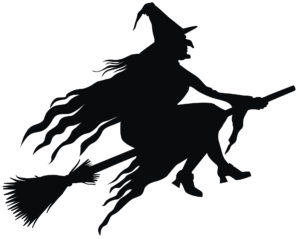
While there are no hard facts about the exact number of Wiccans in the United States, Religious Tolerance estimates that there could be up to three million. Some consider themselves casual believers, while other practitioners proudly call themselves witches. Many encounter common misconceptions about modern witches and find them disconcerting or even infuriating. Meanwhile, others embrace the stereotypical imagery and repurpose it to their benefit.
Misogyny, Pop Culture and Broom-Riding Crones
Our modern imagination is replete with stock images of witches. Slate writer Katy Waldman suggests that the green-skinned, vindictive antagonistic from the 1939 film “The Wizard of Oz” is largely responsible for this, but art critic and BBC contributor Alastair Sooke adds that medieval woodcuts depicting old crones with broomsticks and horned goats may also have shaped perceptions. At the same time, Odyssey writer Jackie Chirco points out that fictional depictions such as the 1996 movie “The Craft” portray witches as beautiful yet power-hungry and malevolent individuals.
Both the “evil seductress” or the “ugly hag” tropes can be misogynistic. In his BBC article, Sooke quotes Deanna Petherbridge, a co-curator for an exhibition of witchcraft imagery in artwork at the British Museum. Petherbridge remarked that some of the depictions “represent the demonization of women” while also functioning as social critique. “Witches are the scapegoats on which the evil of society is projected,” she added.
Black Witches Encounter an Extra Dose of Racism
African-American pagan practitioners also encounter these misconceptions while frequently facing additional racist stereotypes. In her essay in the Digital Literature Review, writer Jillian Simmons discussed how the television show “American Horror Story: Coven” portrayed legendary New Orleans Voodoo priestess Marie Laveau. Simmons openly criticized the series for rendering Laveau as a “merciless villain who uses her power of immortality.”
Indeed, its version of Laveau is directly at odds with historical evidence that suggests she was a benevolent community leader who used her craft and influence for good. Sadly, it may also be part of a pattern in which people of color, especially women, have been associated with evil forms of magic. During the 1692 Salem Witch Trials, a Caribbean slave named Tituba was one of the first individuals accused of bewitching the town’s residents. The History of Massachusetts blog reveals that she falsely confessed to a wide range of bizarre acts after being beaten by her master, Samuel Parris.
Repurposing the Stereotypes for Positive Outcomes
Nevertheless, some modern witches have adopted aspects of these hackneyed portrayals for their own purposes. Waldman disclosed in her Slate article that most do not wear the pointed black hat that’s become a staple of the stereotypes. However, a few have reclaimed it as a visual representation of the Cone of Power, a method for raising energy for ritual practices. Another example comes from a June 2015 article in The Conversation penned by history professor Marguerite Johnson. She mentioned Rosaleen Norton, an Australian occultist and visual artist who was habitually reviled by her country’s mass media for her unusual artwork, ritualistic practices and defiance of conventional social and gender norms. Perhaps to troll her critics, she occasionally donned “witch’s garb” and wholeheartedly embraced her role as “The Witch of Kings Cross.” Although some of her art was destroyed by government officials, surviving works such as “Rites of Baron Samedi” reveal a rich spiritual life and inner world.
Stereotypes about witches have resulted in ostracizing, false accusations, harassment and even death for many individuals throughout history. Today, modern witches from all walks of life fight for religious tolerance and against inaccurate and negative portrayals about Witchcraft and other pagan practitioners. While some openly critique these images, others find ways to use them to achieve beneficial ends. It’s important to remember the cultural legacy, bigotry, misogyny and misperceptions that have crafted these depictions in the first place.

